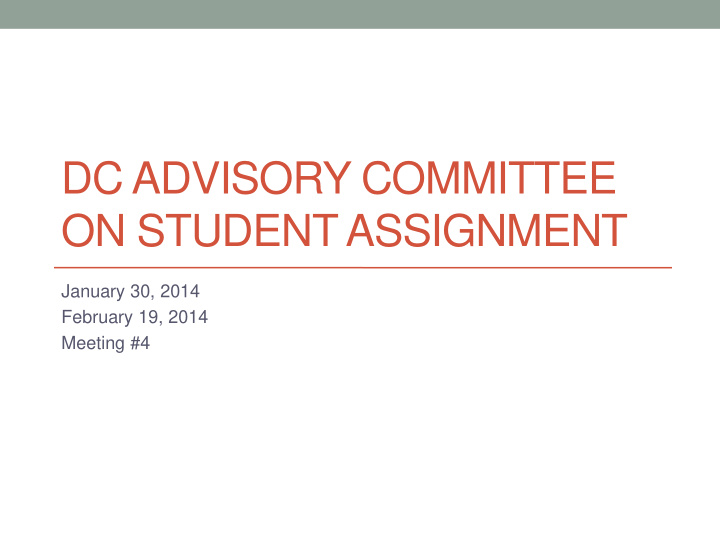



DC ADVISORY COMMITTEE ON STUDENT ASSIGNMENT January 30, 2014 February 19, 2014 Meeting #4
Agenda • Welcome • Update on public input and schedule • Brief overview of Policy Brief #3 • Describe framework for student assignment/choice scenarios • Work in small groups to develop a student assignment/choice scenario for D.C. • Full committee to discuss preliminary proposed scenarios
Goal for Today’s Meeting Advisory Committee develops 3-4 preliminary scenarios for student assignment and choice policy reform for D.C.
Community Input Update • Focus Groups Finished conducting focus groups, but have additional focus group and individual interviews scheduled Coding of focus groups is complete, analysis is underway with write up of findings, in progress, to provide before the February meeting. • Working groups to start in late March or early April • City Council Roundtable on Student Assignment, 1/27/14 • Open meetings hosted by Advisory Committee members • Ward 2, February 8 • Ward 4, February 11 th • Ward 6, February 13-25 • Ward 5, February 18 th • Ward 7, February 27th • Ward 1, March 4 • Ward 3, TBD • Ward 8, TBD • Others?
Policy Brief #3: The Landscape for Student Assignment and School Choice in D.C. • Provides basic data and information on city and neighborhood population and demographics, school characteristics, school- facility infrastructure • Examines school attributes that may be variously considered as causes or effects of student assignment and choice. • Will help us determine implementation tools and help us understand the impact of policy change on specific schools, neighborhoods and communities. • Additional analysis of this data and adding in the building capacity, modernization data and enrollment projections.
Appendix B: Boundary Participation Data Table • The table compares the characteristics of DCPS Boundary School with that of the schools (DCPS or PCS) attended by grade appropriate in- boundary students • This information can help with the scenarios by helping you understand how a particular action might affect families living within particular boundaries. # Students DCPS_Sch Attending Total_Sch PCS_Sch Student Count Count Count Count DCPS School Attended by In Boundary Boundary Student 2012-13 Simon 605 37 49 86 Simon ES 146 Imagine Southeast PCS 62 King, M L ES 44 Friendship PCS SouthEast Academy 36 Eagle Center Wheeler Rd SE 33 Center City Congress Heights Campus PCS 30 Excel Academy PCS 22
Framework for Developing Scenarios Options exist on a spectrum between two extremes: All application All assigned All citywide All neighborhood When developing scenarios: • Don’t be constrained by current policy • Be creative - this is a chance to think outside the box • Think through implications and feasibility • Consider programmatic requirements that will support implementation • Today is just a start – don’t worry about getting your preliminary scenario perfect.
Break into Groups 1) Decide what scenario type you would like to work with • All neighborhood • Mostly neighborhood/some choice • Some neighborhood/some choice • Mostly choice/some neighborhood • All choice 2) Break into 4-5 groups by scenario type • No fewer than 4 people per group
Craft a Preliminary Scenario 1. Identify which sample scenario most closely aligns with your vision of what you think the rights and responsibilities of families and the city should be regarding student assignment and school choice. 2. Create ONE scenario for student assignment and school choice taking elements from the framework and samples and by identifying your own elements.
Test the Concept 3. Identify implementation tools that might be necessary to utilize the Scenario you are exploring and include them in your Scenario. 4. Try to envision the implications of your Scenario for various constituencies. Add other constituencies that you think will be impacted and give examples of how they will be affected by implementation of the Scenario you are exploring. 5. Consider how well each Scenario will advance the guiding principles we have discussed by rating your and other group’ s Scenarios.
Present and Discuss with Committee • Group 1: Present Scenario • Group 2: Present Scenario • Group 3: Present Scenario • Group 4: Present Scenario • Discussion and Rating of each Scenario
Next Steps Technical Team: • Complete interviews of parents and community members • Prepare Focus Group Report Advisory Committee Members: • Review meeting notes before public posting on www.DME.dc.gov • Host discussions in your communities about student assignment and school choice February Meeting Goals Revisit and continue work on the Scenarios from January Meeting Make sure specific concerns/problems with boundaries, feeders, or choice policies that need to be solved are listed out explicitly
Principle ratings for elementary ages Principles Rated for ES: Focus Group and Advisory Committee (N=185; SD .6) ES Equitable Access 4.6 ES Predictable 4.5 ES Strengthens Nbrhd Schools 4.5 ES Proximity 4.3 ES Efficient Use 4.2 ES Simple for parents 4.1 ES Race Diverse 3.9 ES Econ Diverse 3.8 ES Acad Diverse 3.4 ES Simple to admin 3.3 ES Fully Utilizes 3.2 ES Max Choice 3.2 ES Flexibility for LEAs 2.7
Principle ratings for middle schoolers Principles Rated for MS: Focus Groups and Advisory Committee (N=185; SD.6) MS Equitable AccMSs 4.6 MS Predictable 4.4 MS Strengthens Nbrhd Schools 4.2 MS Efficient Use 4.2 MS Simple for parents 4.0 MS Race Diverse 3.9 MS Econ Diverse 3.8 MS Proximity 3.7 MS Simple to admin 3.3 MS Max Choice 3.3 MS Acad Diverse 3.2 MS Fully UtilizMS 3.1 MS Flexibility for LEAs 2.7
Principle ratings for high schoolers Principles Rated for HS: Focus Groups and Advisory Committee (N=185; SD.6) HS Equitable AccHSs 4.6 HS Predictable 4.2 HS Efficient Use 4.2 HS Race Diverse 4.0 HS Strengthens Nbrhd Schools 3.9 HS Simple for parents 3.9 HS Econ Diverse 3.9 HS Max Choice 3.4 HS Simple to admin 3.2 HS Fully UtilizHS 3.1 HS Acad Diverse 3.1 HS Proximity 3.0 HS Flexibility for LEAs 2.7
Recommend
More recommend